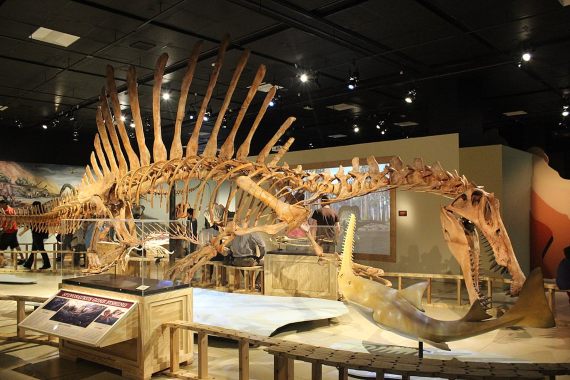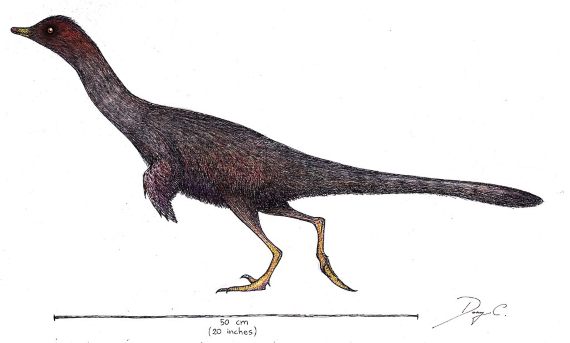Although these days the public’s interest in dinosaurs is inextricably linked to the movie sagas Jurassic Park and Jurassic World, these animals have been a favourite of the human imagination since the Victorian era. This is something that palaeontologist Stephen Jay Gould described as an “archetypal fascination” based on three qualities: “Big, fierce and extinct.” But despite the enormous popularity of these animals, there exists one idea about them that is as widespread as it is wrong, which is that some of them could fly or swim. In fact, neither the winged pterosaurs, nor the mosasaur nor the plesiosaur were actually dinosaurs; only land-living animals fit into this taxonomic group. However, this may not always be the case; once certain exotic theories that have attempted to put all dinosaurs permanently into the water have been ousted, present day science indicates that perhaps a few of those animals were actually fond of much more than just a simple swim.

The idea of aquatic dinosaurs has been to palaeontologists as UFOs have been to astronomers —something that has no clear signs of being anything other than fiction, but that never disappears. In 2012, British author and broadcaster Brian Ford, with no experience in palaeontology, challenged the scientific community with an article published in the magazine Laboratory News in which he proposed “a prehistoric revolution”: “I am now certain that the dinosaurs were primarily aquatic creatures,” he wrote. Ford’s argument is summarised in the title of the book in which he later developed his ideas: Too Big to Walk (Harper Collins, 2018). His original article closed with a bold statement: “All the while we were speculating in science on those remarkable creatures, this single, crucial factor eluded palaeontologists: dinosaurs were aquatic.”
Naturally, the scientific community was quick to react to Ford’s ideas, and they did not do so warmly: “They are pseudoscientific nonsense,” palaeontologist and lecturer David Hone at Queen Mary University in London sums up for OpenMind. “There’s not been a credible palaeontologist who thinks dinosaurs are fundamentally aquatic for 140 years.” However, Hone does add a caveat: “All serious palaeontologists accept the idea that some dinosaurs were semi-aquatic.”
Spinosaurus
The key words that make all the difference are clear: “some” and “semi”. Among the possible candidates, one has attracted the interest of scientists. “Since the 1980s, evidence has gathered which shows that spinosaurids —and Spinosaurus in particular— were atypical among Mesozoic theropods in being closely linked with water,” palaeontologist and science writer Darren Naish at the University of Southampton, who has written extensively refuting Ford’s ideas and even debating them face to face, explains to OpenMind.
Spinosaurids are a group of large bipedal carnivores that were widespread throughout the world in the Jurassic and Cretaceous periods. Today they comprise 13 genera, their most famous representative being the Spinosaurus aegyptiacus, a beast similar in size to the tyrannosaurus and which replaced it as the scourge of the protagonists in the third instalment of the Jurassic Park saga. Although the discovery of the Spinosaurus dates back to the second decade of the 20th century, it was much later research that began to point to a possible partially aquatic way of life, something already suggested for the Baryonyx, a close relative.

Over the years, different lines of evidence have accumulated: “The environments where their fossils are preserved, their jaw anatomy, tooth shape, overall proportions and limb bone thickness, preserved stomach contents and also the isotopes preserved in their tooth enamel,” says Naish; all this has made the biology of Spinosaurus more similar to that of certain aquatic animals such as crocodiles than to that of other theropods. “In the 1980s, it was proposed that spinosaurids were waders; by the 2010s it seemed that they were swimmers, and in the 2020s we have evidence that they were perhaps specialised swimmers,” Naish notes.
But the data have not convinced all the experts. In 2018, palaeontologist Donald Henderson, of the Royal Tyrrell Museum in Alberta, Canada, published a study arguing that the spinosaurid’s buoyancy made it unsinkable, and that this and its stability in the water would not have differentiated it from other theropods such as the tyrannosaurus. Henderson concluded that Spinosaurus may have frequented coastal areas or shallow waters, but that it was primarily a land animal.
A powerful propeller fin
However, new evidence has come to confirm the semi-aquatic habits of the spinosaurid. Unfortunately, the type specimen was lost during an allied bombing raid of Munich during the Second World War, but new fossils have allowed the team led by Nizar Ibrahim, now at the University of Detroit Mercy, to conclude that this animal had numerous adaptations to life in the water. In a recent study published in Nature, Ibrahim, Stephanie Pierce and their collaborators have constructed a robotic model of the tail of the Spinosaurus aegyptiacus, showing that it was nothing more than a powerful propeller fin, very different from the caudal appendage of purely terrestrial dinosaurs. Moreover, the study finds this adaptation, though to a lesser extent, in other spinosaurids, “pointing to a substantial invasion of aquatic environments by dinosaurs,” the authors write.
According to Ibrahim, “this discovery is the nail in the coffin for the idea that non-avian dinosaurs never invaded the aquatic realm.” The palaeontologist says that he can no longer imagine the Spinosaurus as a simple wader that put its legs in the water to hunt fish: “This dinosaur was actively pursuing prey in the water column, not just standing in shallow waters waiting for fish to swim by. It probably spent most of its life in the water.” For Naish, this is a closed case: “Today it is irrefutable that Spinosaurus has a very strong connection with aquatic environments, and was at least amphibious and perhaps aquatic.”

For his part, Hone remains unconvinced. The dinosaur expert stresses that the affinity of certain dinosaurs for water is not really a fundamentally new idea, and that it has been validated by the discovery of species such as the Halszkaraptor, an animal the size of a duck that probably used its forelimbs to swim. However, Hone is still waiting to see more conclusive evidence: “Personally, I don’t think the new Spinosaurus specimen does that.” The palaeontologist sees inconsistencies in the work of Ibrahim and his collaborators, such as the fact that the mobility of spinosaurids in the water would be worse than that of crocodiles, along with anatomical data such as the position of the nostrils, or the isotopic profile of certain specimens suggesting a purely land-based existence. “I am sure Spinosaurus lived in and around water and it could probably swim, but this is not synonymous with it being a very good swimmer that could dive well and swim fast after agile prey as has been presented,” he concludes.
In short, it seems that the debate will continue, but everything indicates that at least we wouldn’t be too wrong if we added a little something to the sentence written on that banner that fell in front of the bellowing tyrannosaurus at the end of the first Jurassic Park movie, and which referred to the title of a British production from 1970: “When Dinosaurs ruled the Earth… and the water”.
Comments on this publication